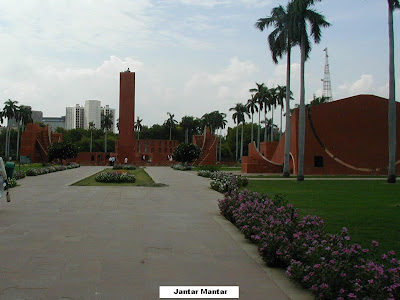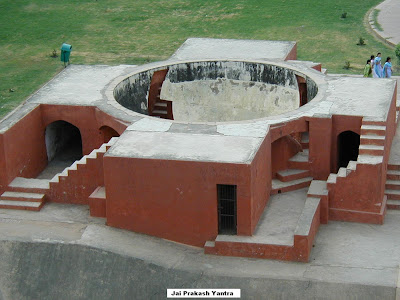 In central Delhi on Sansad Margh between Connaught Place and India Gate is one of the five 18th Century Jantar Mantar astronomical observatories built by Maharaja Sawai Jai Singh II.
In central Delhi on Sansad Margh between Connaught Place and India Gate is one of the five 18th Century Jantar Mantar astronomical observatories built by Maharaja Sawai Jai Singh II.  The Delhi version was built in 1724 and while the brick and plaster “instruments” are in reasonable condition there is significant pollution damage to some of them, such as on the Jai Prakash Yantra. This instrument shows the time, the sun’s declination and the sign of the zodiac.
The Delhi version was built in 1724 and while the brick and plaster “instruments” are in reasonable condition there is significant pollution damage to some of them, such as on the Jai Prakash Yantra. This instrument shows the time, the sun’s declination and the sign of the zodiac.  The impressive Misra Yantra indicates noon in four different locations around the world, the meridian altitude and when the sun enters Cancer.
The impressive Misra Yantra indicates noon in four different locations around the world, the meridian altitude and when the sun enters Cancer. 
The Ram Yantra sits at the southern end of the Jantar Mantar like two giant wheels. The instrument has graduation markings on the floor and walls to provide readings for azimuth and altitude.  The Samrat Yantra can be used to calculate the time correctly to within half a second and the declination of the sun and other stars.
The Samrat Yantra can be used to calculate the time correctly to within half a second and the declination of the sun and other stars.
 The Samrat Yantra can be used to calculate the time correctly to within half a second and the declination of the sun and other stars.
The Samrat Yantra can be used to calculate the time correctly to within half a second and the declination of the sun and other stars.
Jantar Mantar photo collection:
More on the Jantar Mantar: http://www.indiasite.com/delhi/places/jantarmantar.html
 The Suraj Kund on the outskirts of Delhi is a reservoir dating back to the 10th Century and the time of the Rajput Tomar dynasty. The reservoir was built by King Surajpal in a semi-circular design with a temple on the West side. The Tomars first settled in this area before going on to establish the “second” city of Delhi – Lal Kot.
The Suraj Kund on the outskirts of Delhi is a reservoir dating back to the 10th Century and the time of the Rajput Tomar dynasty. The reservoir was built by King Surajpal in a semi-circular design with a temple on the West side. The Tomars first settled in this area before going on to establish the “second” city of Delhi – Lal Kot.  Extensive repairs are believed to have been carried out by Firoz Shah Tughlaq in the 14th Century using a lime “concrete”. The Kund includes a large ramp to give easy access to the water for elephants.
Extensive repairs are believed to have been carried out by Firoz Shah Tughlaq in the 14th Century using a lime “concrete”. The Kund includes a large ramp to give easy access to the water for elephants.
Also here is the site for an annual “mela” which is a major crafts festival held every February. The access to the site (which is not open outside of the festival) is via a number of ceremonial gates illustrating the craft of different regions of India. The Danteshwari Devi Gate has the eponymous Madhya Pradesh mother goddess and her retinue of other deities depicted in the dhokra metal craft tradition. 

The Hoysala Gate depicts the style of 12th Century temple building in Karnataka in South India. The gate has the Hoysala emblem at its centre and depictions of mythical animals.
Suraj Kund photo collection:
More on the Suraj Kund: http://www.indiasite.com/delhi/places/surajkund.html
 The Delhi Zoo is located between Humayun’s Tomb and the Purana Qila but slightly confusingly is often referred to as the Aviary (due to the large bird collection) which made it hard to get directions when I first visited in 2001. Built in the 1950’s the zoo covers 176 acres, and with the entrance/exit at the north end almost
The Delhi Zoo is located between Humayun’s Tomb and the Purana Qila but slightly confusingly is often referred to as the Aviary (due to the large bird collection) which made it hard to get directions when I first visited in 2001. Built in the 1950’s the zoo covers 176 acres, and with the entrance/exit at the north end almost  separate from the grounds it is a long way around especially in the heat.
separate from the grounds it is a long way around especially in the heat.
There are two white tigers, one “proper” one and one that is actually an albino Bengal Tiger. The enclosures are large for these cats who seem quite at home, although some of the lesser cat species are in smaller pens and look a little sorry for themselves as a consequence.
 The 2004 highlight though was the elephants as there was a baby elephant playing in the elephant enclosure pond with mummy elephant.
The 2004 highlight though was the elephants as there was a baby elephant playing in the elephant enclosure pond with mummy elephant.
 The Giraffes seemed very shy of visitors but also rather curious, perhaps they don’t see many short fat hairy Welshmen!
The Giraffes seemed very shy of visitors but also rather curious, perhaps they don’t see many short fat hairy Welshmen!
 It wasn’t clear if there was more than one otter in residence but the one on show was very “talkative”.
It wasn’t clear if there was more than one otter in residence but the one on show was very “talkative”.
In spring 2001 the highlight of my visit was the Black Bucks fighting which was spectacular and at times seemed really quite vicious although there were no serious casualties. There are several large enclosures for different deer species.
 The 2004 highlight though was the elephants as there was a baby elephant playing in the elephant enclosure pond with mummy elephant.
The 2004 highlight though was the elephants as there was a baby elephant playing in the elephant enclosure pond with mummy elephant.  The Giraffes seemed very shy of visitors but also rather curious, perhaps they don’t see many short fat hairy Welshmen!
The Giraffes seemed very shy of visitors but also rather curious, perhaps they don’t see many short fat hairy Welshmen!  It wasn’t clear if there was more than one otter in residence but the one on show was very “talkative”.
It wasn’t clear if there was more than one otter in residence but the one on show was very “talkative”.
I had an interesting visit to the Vivarium in 2004 as I arrived just after feeding time. Dinner was at that time untouched though as in the smaller snake tanks the chicks pecked around happily and in the larger ones  the rabbits hopped around looking for something to nibble. I’ve not seen this approach to feeding live food in any other zoo and was thankful that it wasn’t very busy as I was concerned that if dining had started any bunny/chick lovers would have been badly traumatised! There are a number of small islands to encourage the birds and the largest one has a
the rabbits hopped around looking for something to nibble. I’ve not seen this approach to feeding live food in any other zoo and was thankful that it wasn’t very busy as I was concerned that if dining had started any bunny/chick lovers would have been badly traumatised! There are a number of small islands to encourage the birds and the largest one has a  colony of storks with on my visit in 2004 a lot of young birds still to develop their normal plumage.
colony of storks with on my visit in 2004 a lot of young birds still to develop their normal plumage.
 the rabbits hopped around looking for something to nibble. I’ve not seen this approach to feeding live food in any other zoo and was thankful that it wasn’t very busy as I was concerned that if dining had started any bunny/chick lovers would have been badly traumatised! There are a number of small islands to encourage the birds and the largest one has a
the rabbits hopped around looking for something to nibble. I’ve not seen this approach to feeding live food in any other zoo and was thankful that it wasn’t very busy as I was concerned that if dining had started any bunny/chick lovers would have been badly traumatised! There are a number of small islands to encourage the birds and the largest one has a  colony of storks with on my visit in 2004 a lot of young birds still to develop their normal plumage.
colony of storks with on my visit in 2004 a lot of young birds still to develop their normal plumage.
The bears despite being in large open compounds were a pretty sorry looking lot, the Sloth Bear pacing up and down at some speed and looking very agitated. I can only conclude that his dinner was running VERY late.
Delhi Zoo photo collection:
More on the Zoo:
http://www.nzpnewdelhi.gov.in/

No comments:
Post a Comment